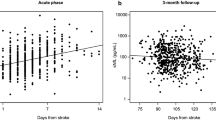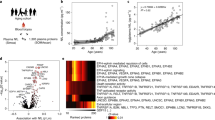Abstract
Neurofilament light chain (NfL), a neuron-specific protein, has been related to several neurodegenerative diseases. In addition, elevated levels of NfL have also been observed in patients admitted to the hospital for stroke, suggesting that NfL as a biomarker may extend well beyond neurodegenerative diseases. Therefore, using data from the Chicago Health and Aging Project (CHAP), a population-based cohort study, we prospectively investigated the association of serum NfL levels with incident stroke and brain infarcts. During a follow-up of 3603 person-years, 133 (16.3%) individuals developed incident stroke, including ischemic and hemorrhagic. The HR (95%CI) of incident stroke was 1.28 (95%CI 1.10–1.50) per 1 standard deviation (SD) increase of log10 NfL serum levels. Compared to participants in the first tertile of NfL (i.e., lower levels), the risk of stroke was 1.68 times higher (95%CI 1.07–2.65) in those in the second tertile and 2.35 times higher (95%CI 1.45–3.81) in those in the third tertile of NfL. NfL levels were also positively associated with brain infarcts; 1-SD in log10 NfL levels was associated with 1.32 (95%CI 1.06–1.66) higher odds of one or more brain infarcts. These results suggest that NfL may serve as a biomarker of stroke in older adults.

Similar content being viewed by others
References
Petzold A. Neurofilament phosphoforms: Surrogate markers for axonal injury, degeneration and loss. J Neurol Sci. 2005;233:183–98 (https://www.ncbi.nlm.nih.gov/pubmed/15896809).
Gaetani L, Blennow K, Calabresi P, Filippo MD, Parnetti L, Zetterberg H. Neurofilament light chain as a biomarker in neurological disorders. J Neurol Neurosurg Psychiatry. 2019;90:870–81 (https://www.ncbi.nlm.nih.gov/pubmed/30967444).
Jin M, Cao L, Dai Y-P. Role of neurofilament light chain as a potential biomarker for alzheimer’s disease: A correlative meta-analysis. Front Aging Neurosci. 2019;11:254 (https://www.ncbi.nlm.nih.gov/pubmed/31572170).
Zhao Y, Xin Y, Meng S, He Z, Hu W. Neurofilament light chain protein in neurodegenerative dementia: a systematic review and network meta-analysis. Neurosci Biobehav Rev. 2019;102:123–38 (https://www.ncbi.nlm.nih.gov/pubmed/31026486).
Falzone YM, Domi T, Mandelli A, Pozzi L, Schito P, Russo T, et al. Integrated evaluation of a panel of neurochemical biomarkers to optimize diagnosis and prognosis in amyotrophic lateral sclerosis. Eur J Neurol. 2022;29:1930–9 (https://www.ncbi.nlm.nih.gov/pubmed/35263489).
Brune S, Høgestøl EA, de Rodez Benavent SA, Berg-Hansen P, Beyer MK, Leikfoss IS, et al. Serum neurofilament light chain concentration predicts disease worsening in multiple sclerosis. Mult Scler. 2022. https://doi.org/10.1177/13524585221097296 (https://www.ncbi.nlm.nih.gov/pubmed/35658739).
Vijiaratnam N, Lawton M, Heslegrave AJ, Guo T, Tan M, Jabbari E, et al. Combining biomarkers for prognostic modelling of parkinson’s disease. J Neurol Neurosurg Psychiatry. 2022;3(7):707–15 (https://www.ncbi.nlm.nih.gov/pubmed/35577512).
Shahim P, Zetterberg H, Tegner Y, Blennow K. Serum neurofilament light as a biomarker for mild traumatic brain injury in contact sports. Neurology. 2017;88:1788–94 (https://www.ncbi.nlm.nih.gov/pubmed/28404801).
Uphaus T, Bittner S, Gröschel S, Steffen F, Muthuraman M, Wasser K, et al. NfL (neurofilament light chain) levels as a predictive marker for long-term outcome after ischemic stroke. Stroke. 2019;50:3077–84 (https://www.ncbi.nlm.nih.gov/pubmed/31537188).
Stokowska A, Käll LB, Blomstrand C, Simren J, Nilsson M, Zetterberg H, et al. Plasma neurofilament light chain levels predict improvement in late phase after stroke. Eur Journal Neurol. 2021;28:2218–28 (https://www.ncbi.nlm.nih.gov/pubmed/33811783).
Chen C-H, Chu H-J, Hwang Y-T, Lin Y-H, Lee C-W, Tang S-C, et al. Plasma neurofilament light chain level predicts outcomes in stroke patients receiving endovascular thrombectomy. J Neuroinflammation. 2021;18:195 (https://www.ncbi.nlm.nih.gov/pubmed/34511123).
Wang Z, Wang R, Li Y, Li M, Zhang Y, Jiang L, et al. Plasma neurofilament light chain as a predictive biomarker for post-stroke cognitive impairment: a prospective cohort study. Front Aging Neurosci. 2021;13:631738 (https://www.ncbi.nlm.nih.gov/pubmed/33679379).
Qu Y, Tan C-C, Shen X-N, Li H-Q, Cui M, Tan L, et al. Association of plasma neurofilament light with small vessel disease burden in nondemented elderly: a longitudinal study. Stroke. 2021;52:896–904 (https://www.ncbi.nlm.nih.gov/pubmed/33517704).
Sanchez JD, Martirosian RA, Mun KT, Chong DS, Llorente IL, Uphaus T, et al. Temporal patterning of neurofilament light as a blood-based biomarker for stroke: A systematic review and meta-analysis. Frontiers Neurol. 2022;13:841898 (https://www.ncbi.nlm.nih.gov/pubmed/35651349).
Heshmatollah A, Fani L, Koudstaal PJ, Ghanbari M, Ikram MA, Ikram MK. Plasma beta-amyloid, total-tau, and neurofilament light chain levels and the risk of stroke: a prospective population-based study. Neurology. 2022;98:e1729–37 (https://www.ncbi.nlm.nih.gov/pubmed/35232820).
Tsao CW, Aday AW, Almarzooq ZI, Alonso A, Beaton AZ, Bittencourt MS, et al. Heart disease and stroke statistics 2022 update: a report from the american heart association. Circulation. 2022. https://doi.org/10.1161/CIR.0000000000001052.
Bienias JL, Beckett LA, Bennett DA, Wilson RS, Evans DA. Design of the chicago health and aging project (CHAP). J Alzheimer’s Dis : JAD. 2003;5:349–55 (https://www.ncbi.nlm.nih.gov/pubmed/14646025).
Dhana K, Franco OH, Ritz EM, Ford CN, Desai P, Krueger KR, et al. Healthy lifestyle and life expectancy with and without Alzheimer’s dementia: population based cohort study. BMJ. 2022. https://doi.org/10.1136/bmj-2021-068390.
Rajan KB, Aggarwal NT, McAninch EA, Weuve J, Barnes LL, Wilson RS, et al. Remote blood biomarkers of longitudinal cognitive outcomes in a population study. Ann Neurol. 2020;88:1065–76 (https://www.ncbi.nlm.nih.gov/pubmed/32799383).
Desai P, Dhana K, DeCarli C, Wilson RS, McAninch EA, Evans DA, et al. Examination of neurofilament light chain serum concentrations, physical activity, and cognitive decline in older adults. JAMA Netw Open. 2022;5:e223596 (https://www.ncbi.nlm.nih.gov/pubmed/35315915).
Rajan KB, Schneider JA, Aggarwal NT, Wilson RS, Everson-Rose SA, Evans DA. Racial differences in cognitive function and risk of incident stroke. J Stroke Cerebrovasc Dis: Off J Natl Stroke Assoc. 2015;24:2854–9 (https://www.ncbi.nlm.nih.gov/pubmed/26387044).
Rajan KB, Aggarwal NT, Schneider JA, Wilson RS, Everson-Rose SA, Evans DA. Role of APOE e4 allele and incident stroke on cognitive decline and mortality. Alzheimer Dis Assoc Disord. 2016;30:318–23 (https://www.ncbi.nlm.nih.gov/pubmed/27849638).
Dhana K, Aggarwal NT, Beck T, Holland TM, Dhana A, Cherian LJ, et al. Lifestyle and cognitive decline in community-dwelling stroke survivors. J Alzheimer’s Dis. 2022;89:745–54. https://doi.org/10.3233/JAD-220305.
Cornoni-Huntley J, Ostfeld AM, Taylor JO, Wallace RB, Blazer D, Berkman LF, et al. Established populations for epidemiologic studies of the elderly: Study design and methodology. Aging. 1993;5:27–37 (https://www.ncbi.nlm.nih.gov/pubmed/8481423).
DeCarli C, Reed T, Miller BL, Wolf PA, Swan GE, Carmelli D. Impact of apolipoprotein e epsilon4 and vascular disease on brain morphology in men from the NHLBI twin study. Stroke. 1999;30:1548–53 (https://www.ncbi.nlm.nih.gov/pubmed/10436099).
Aggarwal NT, Wilson RS, Bienias JL, De Jager PL, Bennett DA, Evans DA, et al. The association of magnetic resonance imaging measures with cognitive function in a biracial population sample. Arch Neurol. 2010;67:475–82 (https://www.ncbi.nlm.nih.gov/pubmed/20385915).
DeCarli C, Massaro J, Harvey D, Hald J, Tullberg M, Au R, et al. Measures of brain morphology and infarction in the framingham heart study: establishing what is normal. Neurobiol Aging. 2005;26:491–510 (https://www.ncbi.nlm.nih.gov/pubmed/15653178).
Boehme AK, Esenwa C, Elkind MSV. Stroke risk factors, genetics, and prevention. Circ Res. 2017;120:472–95 (https://www.ncbi.nlm.nih.gov/pubmed/28154098).
Liu D, Chen J, Wang X, Xin J, Cao R, Liu Z. Serum neurofilament light chain as a predictive biomarker for ischemic stroke outcome: a systematic review and meta-analysis. J Stroke Cerebrovasc Dis: Off J Nat Stroke Assoc. 2020;29:104813 (https://www.ncbi.nlm.nih.gov/pubmed/32305278).
Pedersen A, Stanne TM, Nilsson S, Klasson S, Rosengren L, Holmegaard L, et al. Circulating neurofilament light in ischemic stroke: temporal profile and outcome prediction. J Neurol. 2019;266:2796–806 (https://www.ncbi.nlm.nih.gov/pubmed/31375988).
Korley FK, Goldstick J, Mastali M, Van Eyk JE, Barsan W, Meurer WJ, et al. Serum NfL (neurofilament light chain) levels and incident stroke in adults with diabetes mellitus. Stroke. 2019;50:1669–75 (https://www.ncbi.nlm.nih.gov/pubmed/31138085).
Tiedt S, Duering M, Barro C, Kaya AG, Boeck J, Bode FJ, et al. Serum neurofilament light: a biomarker of neuroaxonal injury after ischemic stroke. Neurology. 2018;91:e1338–47 (https://www.ncbi.nlm.nih.gov/pubmed/30217937).
Yan J, Greer JM, Etherington K, Cadigan GP, Cavanagh H, Henderson RD, et al. Immune activation in the peripheral blood of patients with acute ischemic stroke. J Neuroimmunol. 2009;206:112–7 (https://www.ncbi.nlm.nih.gov/pubmed/19058859).
Shichita T, Sugiyama Y, Ooboshi H, Sugimori H, Nakagawa R, Takada I, et al. Pivotal role of cerebral interleukin-17-producing gammadeltaT cells in the delayed phase of ischemic brain injury. Nat Med. 2009;15:946–50 (https://www.ncbi.nlm.nih.gov/pubmed/19648929).
Acknowledgements
The authors thank all participants of the CHAP study and the research assistants, psychologists, and physicians for their efforts in the conduct of the fieldwork.
Funding
This study was supported by the National Institutes of Aging of the National Institute of Health under Award Number: R01AG051635, RF1AG057532, R01AG073627, R01AG058675, U19NS120384, P30AG072972 and T32AG050061. The content is solely the responsibility of the authors and does not necessarily represent the official views of the National Institute of Health.
Author information
Authors and Affiliations
Contributions
Conception and design of the study (AD, CSD, NTA, KD, PD, DAE, KBR). Acquisition and analysis of data (AD, CSD, KBR). Drafting a significant portion of the manuscript or figures (AD, CSD, NTA, KD, PD, KBR).
Corresponding author
Ethics declarations
Conflict of interest
All authors have nothing to declare.
Ethical approval
The study was approved by the Rush University Medical Center Institutional Review Board. All study participants provided written informed consent.
Additional information
Publisher's Note
Springer Nature remains neutral with regard to jurisdictional claims in published maps and institutional affiliations.
Supplementary Information
Below is the link to the electronic supplementary material.
Rights and permissions
Springer Nature or its licensor (e.g. a society or other partner) holds exclusive rights to this article under a publishing agreement with the author(s) or other rightsholder(s); author self-archiving of the accepted manuscript version of this article is solely governed by the terms of such publishing agreement and applicable law.
About this article
Cite this article
Dhana, A., DeCarli, C., Aggarwal, N.T. et al. Serum neurofilament light chain, brain infarcts, and the risk of stroke: a prospective population-based cohort study. Eur J Epidemiol 38, 427–434 (2023). https://doi.org/10.1007/s10654-023-00978-6
Received:
Accepted:
Published:
Issue Date:
DOI: https://doi.org/10.1007/s10654-023-00978-6




